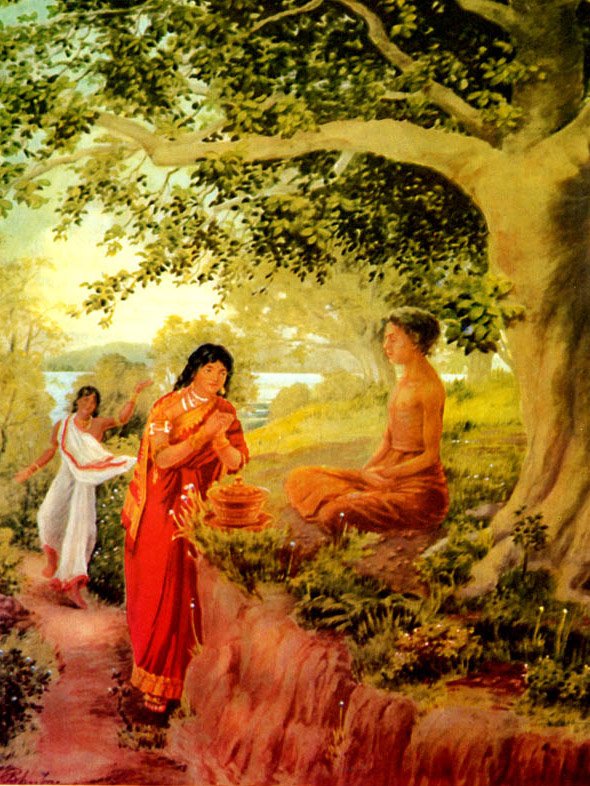Apadana commentary (Atthakatha)
by U Lu Pe Win | 216,848 words
This is the English translation of the commentary on the Apadana (Atthakatha), also known as the Visuddhajana-Vilasini. The Buddhist stories known as apadanas refer to biographies of Buddhas, Buddhist monks and nuns. They are found in the Pali Canon (Khuddaka Nikaya), which is the primary canon of Theravada Buddhism. Alternative titles: Visuddhaja...
Commentary on Biography of the thera Bhāgineyyupāli
Stanzas, starting with Khīṇāsavasahassehi constitute the biography of the venerable thera Bhāgineyyupāli, nephew of venerable Upāli. This thera, indeed, having done devoted service toward former Buddhas, accumulating meritorious deeds 8n this and that existence, was reborn in a family at the time of the Glorious One Padumuttara. As he grew up, he noticed (or came to see) disadvantage in setting up a household life, abandoned his house, renounced the world, became an ascetic, gained five kinds of higher knowledge and eight kinds of prosperous jhāna and took up his residence in Himalaya. The hermit saw the Glorious One shining like the fullmoon even from afar, became pious-minded pleasingly, made his antelope skin stationed on his shoulder, raised his clasped hands, paid his homage, properly placed on his head the clasped combination of ten nails, while still standing, and praised the Glorious One with many an illustration, and with words of eulogy. Having heard his praise, the Glorious One gave prophecy to him thus:- "This hermit in future, during the dispensation of the Glorious One named Gotama, will become monk, and turn out to be the chief among those who have sharp knowledge (tkhiṇa paññā) in the Vinaya". He stood as long as his span of life lasted and being one with undiminished jhāna all-round was reborn in the brahma world. Having passed away thence, he wandered about his rounds of rebirths, enjoyed prosperity among divine and human-beings, was reborn, when this Buddha arose in the city of Kapilavatthu as the son of the sister of the thera Upāli. Having gradually grown up, he became a monk in the presence of his uncle the thera Upāli, took mental exercise (kammaṭṭhāña) developed clear insight (vipassanā) and before long even, became an arahat. Because he resided near his own teacher, he became sharp-witted in the problems of discipline (vinaya). Then the Glorious One placed him in the topmost position thus: "O bhikkhus! Among my disciples, bhikkhus who are sharp-witted in problems of discipline (vinaya), this one is the chief, namely Bhāgineyyupāli.
1. Having thus attained the topmost ranking position, he remembered his own former deed became delighted and uttered a stanza starting with khīṇā savasahassehi, in order to make manifest the deed done by him formerly. Thus: ā (up to), from all sides up to the highest heaven (bhavagga), flow, turn out to be; thus, cankers (āsava); the four kinds of such cankers as cankers of sensual pleasures and so on; those, by whom the cankers had been exhausted, dried up, especially evaporated, clearly crushed; thus, the canker-free, khīṇāsavā; a thousand of those selfsame ones, a thousand canker-free; by those thousand canker-free arahats; pareto, surrounded; Lokanāyako, the leader of the world to nibbāna, went to become alone to live singly, devoted to seclusion; thus, is the connection.
2. Ajinenanivattho'ham (I was dressed in antelope skin), i was properly covered over with the skin of an antelope-deer, the wearer of antelope skin; thus, is the meaning. Tidaṇḍa paridhārako (all-round bearer of three sticks) took tripod (tidaṇḍa), for the purpose of placing the water goblet and bearing the same; thus, is the meaning. I saw (or met) the leader of the world surrounded by the clergy of bhikkhus in their all-round array; thus, is the connection. The rest is but clear.
The commentary on the biography of the thera Bhāgineyyupāli has ended.
